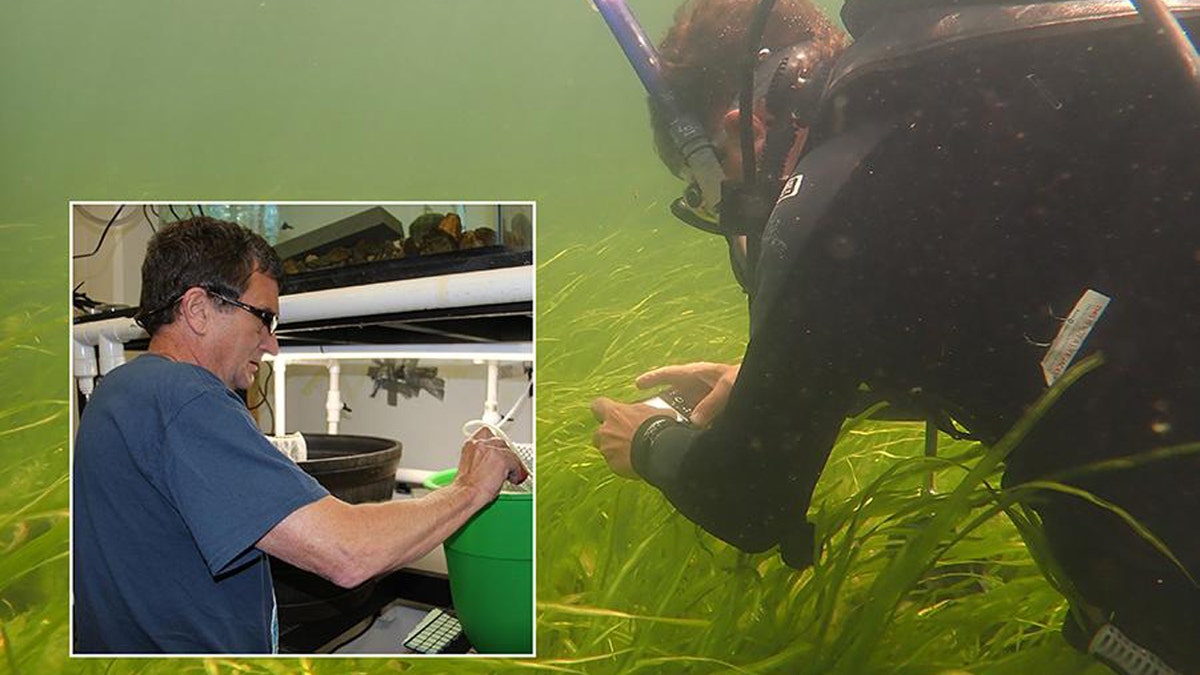Fox News Flash top headlines for August 21
Fox News Flash top headlines are here. Check out what's clicking on Foxnews.com.
Researchers in Pennsylvania are aiming to restore a small fish species that reportedly has "no commercial value" or "recreational importance" as they attempt to prevent it from being placed on the federal endangered species list.
Pennsylvania State University announced it has been working with the Pennsylvania Fish and Boat Commission and other wildlife experts to prevent the Chesapeake logperch from going extinct.
Chesapeake logperch are a unique and rare bottom-dwelling fish species that have stripes and a greenish-gold hue, according to the U.S. Fish and Wildlife Service (FWS).
The FWS reports that the fish species is typically found in the Lower Potomac watershed that’s between Maryland and Virginia and the Susquehanna River watershed that includes parts of New York, Pennsylvania and Maryland – both of which flow into the Chesapeake Bay.

The Chesapeake logperch, a bottom-dwelling fish that researchers believed to only ever have inhabited the lower drainages of the Potomac and Susquehanna rivers, is now considered an endangered species in Pennsylvania and Maryland. (Pennsylvania State University)
However, Penn State has also found Chesapeake logperch in the Allegheny River from tributaries in Lake Erie and the Mississippi River drainage from Illinois and Minnesota, according to a news release the university published in June.
The Chesapeake logperch is considered an endangered fish species in Pennsylvania and Maryland, and researchers at Penn State are moving to restore the populations before the Chesapeake logperch is added to the federal endangered species list.
"We don't want to see that happen, because the Chesapeake logperch being federally listed would cause a lot of problems with development in the lower Susquehanna River basin and also with development around the upper Chesapeake Bay," Jay Stauffer, a professor of ichthyology (fish zoology) at Penn State, said in a statement.
Pollution and predation from "voracious invasive" fish, such as the northern snakehead, flathead catfish and blue catfish, have put the Chesapeake logperch at risk of extinction, according to Penn State.
VIRGINIA FISHERMAN REELS IN RARE LARGEMOUTH BASS FROM RIVER: 'HAVEN'T SEEN ANYTHING LIKE THAT'
In the last four years, researchers have been capturing Chesapeake logperch and analyzing where they come from while also breeding the fish in labs and tagging before their release into local waters.

Jay Stauffer, a researcher and ichthyology professor at Pennsylvania State University, has conducted underwater snorkel surveys in sections of the lower Susquehanna and select tributaries, where he's captured Chesapeake logperch and cultured the fish in a lab for population boosting. (Pennsylvania State University)
About 2,000 Chesapeake logperch have been bred in Penn State facilities and introduced into select spots of the Susquehanna River drainage, according to the university.
"We tagged all Chesapeake logperch that were cultured before releasing them so they could be identified later, and we were able to recapture a few around Columbia," Stauffer said in the statement.
"And we also put electronic tags in a whole series of fish we put in Conodoguinet Creek, to see if they migrate out to the Susquehanna River," he continued. "Unfortunately, we didn’t have enough time to see if they came back to spawn, so we're continuing some of this work and seeking other funding."
HALF-EATEN FISH REELED IN BY CONNECTICUT ANGLERS SHOWS 'REAL PROBLEM' FISHERMEN FACE NATIONWIDE
The Chesapeake logperch restoration project has been funded by grants from the Pennsylvania Fish and Boat Commission and the Pennsylvania Wild Resources Fund, which have totaled $500,000 so far, according to Penn State’s news release.

About 2,000 Chesapeake logperch that were cultured at Pennsylvania State University were tagged before their release in Pennsylvania's Conodoguinet Creek, so they could be identified later. Researchers want to see if the tagged fish will migrate to the Susquehanna River. (Pennsylvania State University)
Penn State’s news release on the restoration project claims Chesapeake logperch have no commercial or recreational value, but researchers believe preventative measures should be taken.
"If it goes extinct, we have lost another species that inhabits the earth," said Stauffer, in a statement. "I think there is something to be said for preserving the biodiversity of our aquatic systems. When a species goes extinct, it's gone forever. You don't get it back."
Stauffer added that he thinks his team can restore the Chesapeake logperch to its original distribution in the Susquehanna River, but it’s likely going to require more time for culturing, translocating and reintroduction efforts.
CLICK HERE TO GET THE FOX NEWS APP
Pennsylvania researchers aren’t the only group showing concern for Chesapeake logperch.
The FWS is currently looking into conservation measures along with the Maryland Department of Natural Resources and other wildlife groups.
CLICK HERE TO SIGN UP FOR OUR LIFESTYLE NEWSLETTER
"As part of this effort, the Northeast Fishery Center is developing and implementing species propagation strategies to augment populations and restore the Chesapeake logperch within and beyond its current range," the FWS wrote in an overview of the fish species. "The Service will be reviewing the logperch’s status in 2023 to determine whether or not it needs federal protection."






















